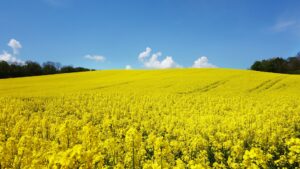Neonicotinoids have been controversial and under scrutiny in the U.S. for years. Farmers in the United Kingdom are learning to live with their new reality as they adjust to life without.
Editor’s Note: This piece originally ran in our sister publication, Germination, but we at Seed World felt this article was important for our readers to learn about policies in place in the U.K. and responses when it comes to neonicotinoids.
The United Kingdom may no longer be part of the European Union (EU), but the EU’s presence still lingers. Following years of environmental regulations crimping farming practices, farmers are still finding themselves grappling with EU-enacted controls including the ban on neonicotinoid insecticides which flipped regular farming practices upside down.
In Britain, farmers have been forced to become creative to try and protect their crops against pest infestations. Despite their best efforts, the pests still plague them and they’re stuck waiting on science to catch up to the regulations, says Scott Cockburn, business manager for Syngenta Crop Protect in the United Kingdom.
The EU regulations date back to 2013 when the European Council placed restrictions on the use of clothianidin, imidacloprid, thiamethoxam and fipronil, banning their use on flowering crops which appeal to honeybees and other pollinating insects. The decision was made based on studies stating bees were dying due to the insecticide use. The regulations became more wide-ranging in 2018, with full bans enacted.
Across the pond, the studies on pollinating insects and insecticides have caught the attention of North American governments. In 2016, the Canadian government first proposed a phase-out of all agricultural uses of imidacloprid, as the insecticides were accumulating in ponds, creeks and other water bodies near agricultural land. Two years later, the same phase-out recommendation was made for thiamethoxam and clothianidin. The decision is still pending.
While the United States has no current proposals to ban the use of neonic products, they have been under increased scrutiny. The U.S. Environmental Protection Agency (EPA) has banned 12 products from Syngenta, Valent and Bayer. The EPA currently allows 47 other neonics to be used, but those could be phased-out in 2022 when they undergo the re-registration process. Some states have also enacted their own personal restrictions on neonics.
In the U.K., farmers have struggled with life after neonics for years. Cereal crops have been easier to manage, but others, like rapeseed, are challenging and acreage has started to fall. Flea beetle infestations have been getting worse with larvae now being found in the stems of the rapeseed plants — unheard of before the ban.
“It’s not uncommon to split main stems in early spring and find 30 larvae in the main stem,” Cockburn says. “In the worst-case scenario, they’re completely severing the main stem, so the plant just dies.”
In winter cereals, farmers have experimented with agronomic practices to try and protect their crops. They have started using minimal tillage, although Cockburn says they are behind compared to Canada on no-till practices.
Stubble hygiene has also been tried out, although this relies heavily on the use of glyphosate which is another whole debate. Chemical control has been used, but pests, such as aphids, are starting to show chemical resistance.
Cover crops have been experimented with. Farmers have also tried seeding at later dates — the crops germinate in colder temperatures, killing the aphids off. Companies have even begun marketing precision agriculture tools to help determine optimal seeding dates to beat aphid attacks.
Rapeseed farmers have also been playing around with similar practices. Some have tried seeding their winter rapeseed crops at earlier dates, claiming it causes better stand establishment, making them able to with withstand infestations. Others argue a later seeding date works better as their crop misses the window for the main aphid attack. Some have used higher seeding rates to try and dilute infestations, however if all plants reach maturity, the crop is then overcrowded.
Others have tried alternative other crops, such as linseed, maize, soybeans, sunflowers or pulses, instead of rapeseed in their rotations. Trap cropping, where the previous rapeseed stubble is left out for the flea beetles to attack while the new crop germinates, has been experimented with. Cover crops, such as mustard, have been used, with some even grazing sheep on the crop. No-till and chemical treatments have been experimented with. Some farmers claim the flea beetle infestations are worse at night, so they’ll spray for them then.
“We’re getting lots of theories with all of this. People want to do things that they’ll swear blind at,” Cockburn says. But so far no one has been able to crack the code and find the perfect pest control method.
Moving forward, the industry will start to catch up to the regulations and will release new products to assist farmers in their fight against pests, Cockburn expects.
New crop breeds like RAGT’s soon-to-be-available Wolverine BVDV resistant winter wheat variety will be able to withstand aphid attacks, Cockburn says. In the long-term new biocontrols, biostimulants and sprayable pheromones should hit the U.K. market to protect cereals like winter wheat.
Rapeseed, on the other hand, faces a tougher future. The viability of the crop will depend on new pesticide discoveries and biocontrols. There is hope, though, as white mustard has pest resistance and it is related to rapeseed. Cockburn suspects those resistance genes will be brought into future rapeseed varieties.
“Undoubtedly we will get new pesticide discoveries. They will come along, but they’re fewer and harder to find nowadays,” he says.











